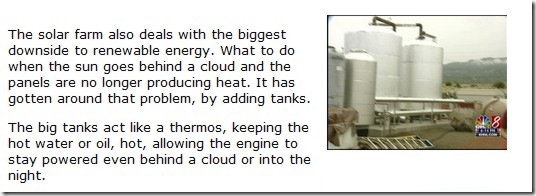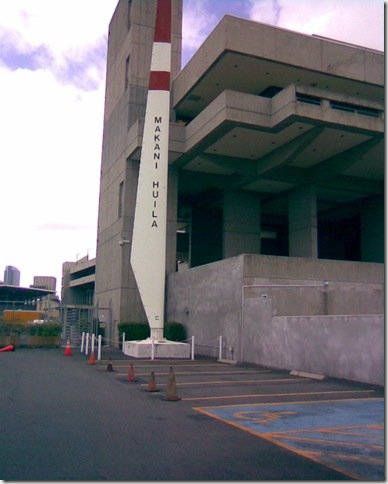Sunday, April 26, 2009
Why wind won’t work
by Larry Geller
I’m going to stick my neck out a little here. It’s very unfashionable to criticize alternative energy plans these days. But if you’ve been following this blog, you know that I would like to see the end of oil-burning generators in Hawaii immediately, if not sooner.
I think wind power is going to run into so much trouble here that the result will be to delay the turn-down of those dinosaur turbines. This can only please HECO, which can appear to support wind power while expecting it to fail.
So what’s the alternative to the alternative? It’s likely to be solar or wave power (no harm to view planes).
Wind will run into trouble because the little wind generators don’t work and the large ones will meet with objections from residents and developers. Who wants wind turbines in their back yards? No one. What developer wants to put up homes in the shadow of monster windmills, or see the value of their property devalued by the unsightly rotating machines in the view plane? None. And don’t forget, developers run this town.
Over on Lanai, Castle & Cook would like to sell power to Oahu. I suppose, if we can’t install our own wind turbines, that idea has its attractions. But the price of copper cable is going up, and to transfer power between islands is going to be expensive. Moreover, Lanai residents will very reasonably object to this uglifying plan. In an article in today’s Advertiser:
…The aesthetics of the $750 million power project trouble some visitors and residents. It would put 400-foot-tall wind turbines next to Polihua Beach, the longest white-sand stretch on the island.
"I am not going to live on an island that's the biggest wind farm in the Pacific," said John Mumford, 65, founding partner of Crosspoint Venture Partners, a Woodside, Calif., venture-capital firm, who owns a vacation home on Lana'i.
Having fields of windmills would erode the island's natural beauty, said Marc Masterson, 53, artistic director at the Actors Theatre of Louisville in Kentucky, who went fishing at Polihua a year ago.
,,,
"It's a place a lot of people use for hunting deer, fishing and diving," said Robin Kaye, 62, a retired photographer who lives on Lana'i. "Why should this island be the power generator for O'ahu? Let them build a wind farm there." [Honolulu Advertiser, Lana'i awhirl over wind power, 4/26/2009]
Each island might start by generating its own electricity to meet local needs. That has at least a chance of being cost effective and might reduce the eyesore on Lanai. Perhaps I’m wrong. Geographical diversity is an advantage, if Oahu already had its own wind farms. In other words, when the wind doesn’t blow here, it might still be blowing on Lanai, and vice versa (though it seems there’s no plan to benefit Lanai at all in this project).
Oahu residents won’t want wind farms in their backyards either, of course (no one does). From yesterday’s Star-Bulletin:
Kahuku resident Kent Fonoimoana said he feels a proposed site for wind turbines to generate electricity is too close to his home.
"It's not good if it's right here," he said, noting that West Wind Works LLC's site is about a quarter mile away.
"It's going to have a negative impact on property values."
…
Officials said [Oregon developer] West Wind has been successfully developing wind energy in Hawaii for the past 25 years and was involved in the initial feasibility study for Kaheawa on Maui.Carol Anamizu, a ti leaf farmer, said she lives about a half mile from the [meteorological test] towers and feels the company needs to talk with the community about its plan.
"I don't have any problems with the thing if the community is going to benefit from it," she said.
"For myself, I'm not too happy. It might be an eyesore." [Star-Bulletin, Residents question new wind turbine site, 4/25/2009]
When the wind doesn’t blow on Lanai, which happens often enough, the power won’t flow to Oahu. It is possible to store energy for example by pumping water uphill into a reservoir, and letting it flow down again through a hydroelectric generator system. But no one is proposing to build reservoirs that I’m aware of.
Ok, let’s jump to solar power. Guess what—here’s a solar generation system that stores its energy, invented right here in Hawaii. Why not fill the pineapple and sugar fields with something like this? The snippet below is from a KHNL feature, Hawaii solar farm is first of its kind in the world, 4/23/2009, describing a concentrating solar project created by Hawaii company Sopogy:
Check out their webpage also.
Before we leave this topic, let’s check in with the dinosaur Hawaiian Electric Company. They were supposed to have a photovoltaic solar generator on the roof of their Archer Substation at their Ward Avenue facility by the end of 2008. I understand that the problem lies with Hoku Scientific, Inc., although I don’t know the details. Anyway, it’s not there yet. If they can’t do one roof, what can we expect for large scale generation?
As to wind, they have this great monument to wind energy in front of their Ward Avenue building, taking up a couple of parking spaces:
I don’t know the history of this blade but suspect it is from the HEI Kahuku Wind Farm described on the HECO web page, Hawaiian Electric has pioneered wind energy development and research:
A primary reason for the formation of Hawaiian Electric’s parent company, HEI, in the early 1980s was to develop wind energy. HEI invested more than $25 million through a non-regulated subsidiary to develop a 9-MW wind farm at Kahuku. HEI invested another $7 million in a 3.2 MW wind turbine at the same location -- the 360-ft. MOD-5-B – which was then the world's largest horizontal axis wind turbine. The Kahuku wind farm suffered from winds that were more turbulent than expected and mechanical problems with the first-generation turbines, resulting in low energy production. In addition, a dramatic drop in the price of oil made the wind farm too costly to operate. It has since been closed and the turbines dismantled, but the operations provided useful research information.
So ok, they were pioneers, in the 1980s, but the thing is now parked in their lot. Others are generating power from wind. There are plenty of generators available that won’t crap out. It’s nice that they were pioneers, but it’s 2009, the sun is shining in Hawaii, the wind is blowing, the waves are lapping, and they are still burning fossil fuel.
So that experiment did not lead to production. The community will object to unsightly wind turbines near homes. Birds may or may not be killed by wind turbines, but it’s a concern that needs to be addressed. It’s all a recipe for failure, and for the perpetuation of fossil fuel burning in a land with abundant alternative sources.
(Speaking of the environment, why not uproot the GMO corn fields and make honest electricity in that space? What a powerful statement that would be. Evil replaced by good.)
By changing the regulatory framework and selecting appropriate technology we can move forward. Think: independent power grid, feed-in tariff, each island self-sufficient. Think wave power. Think solar (do those Sopogy systems barbeque birds? Just asking…) Let Lanai keep its power for its own use, and let’s get busy on Oahu with cost-effective solutions to our own power needs.
This will lead to finding independent energy source for each island, which is a more sustainable option.
Alternative energy is one of the biggest problem the whole world is facing. There are many alternative energy that has been discovered and used but none of these sources of energy can be used at all times. The only way to utilize these technologies in an environmentally sound way is to combine all of them.
<< Home





Post a Comment
Requiring those Captcha codes at least temporarily, in the hopes that it quells the flood of comment spam I've been receiving.